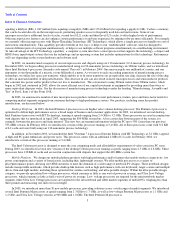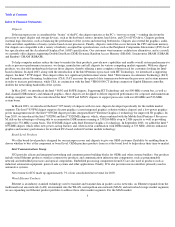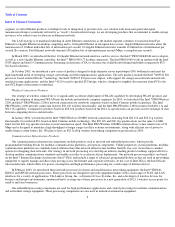Intel 2003 Annual Report Download - page 16
Download and view the complete annual report
Please find page 16 of the 2003 Intel annual report below. You can navigate through the pages in the report by either clicking on the pages listed below, or by using the keyword search tool below to find specific information within the annual report.
Table of Contents
Index to Financial Statements
Intel Architecture Business
For the desktop platform, our strategy is to introduce microprocessors and chipsets with higher performance and/or advanced technology
features, tailored to the needs of different market segments using a tiered branding approach. For the mobile platform, our strategy is to deliver
products optimized for some or all of the four mobility vectors: performance, battery life, form factor and wireless connectivity. For the
enterprise platform, our strategy is to provide processors and chipsets with high performance and/or advanced technology features, as well as
competitive price for performance for entry-level to high-end servers and workstations.
Our financial results are substantially dependent on microprocessor sales by the Intel Architecture operating segment. Many of our
competitors (including Advanced Micro Devices, Inc. (AMD), our primary microprocessor competitor) market software-compatible products
that are intended to compete with Intel architecture-based processors. We also face competition from companies offering rival microprocessor
designs, such as International Business Machines Corporation (IBM), which supplies microprocessors to Apple Computer, Inc. AMD has
introduced microprocessor product offerings for the desktop and server market segments that are based on 32-bit architecture with 64-bit
memory address extensions. Microprocessors with 64-bit addressing capability can address significantly more memory than 32-bit
microprocessors. We currently have desktop and server microprocessor product offerings based on our IA-32 architecture, and we offer the
Intel Itanium processor family, based on 64-bit architecture, for enterprise-class servers and supercomputing solutions. We believe that the
features of the Itanium architecture, including high-end performance, scalability, 64-bit addressing and reliability, provide capabilities that
users in this market segment require. We plan to introduce Intel Xeon processors based on the IA-32 architecture with 64-bit extension
technology for workstations and servers in mid-2004. We continuously evaluate all of our product offerings and the timing of their
introduction, taking into account factors such as customer requirements, availability of infrastructure to take advantage of product features and
maturity of applications software for each type of processor in the relevant market segments. Any decision to make microprocessors with 64-
bit
extension technology available in the desktop or other market segments will be based on both timing of availability of the infrastructure
(including an operating system geared toward consumers) required to support them and demand for these processors from our OEM customers.
Competitive product offerings continue to increase in the market segments where we have product offerings. Our desktop processors
compete with products offered by AMD, IBM and VIA, among others. Our mobile microprocessor products compete with products offered by
AMD, IBM, Transmeta Corporation and VIA, among others. Our server processors compete with software-compatible products offered by
AMD and with established products based on rival architectures, including those offered by Hewlett-Packard Company, IBM and Sun
Microsystems, Inc. Our chipsets compete in the various market segments against different types of chipsets that support either our
microprocessor products or rival microprocessor products. Competing chipsets are produced by companies such as ATI Technologies, Inc.,
Broadcom, NVIDIA, Silicon Integrated Systems Corporation (SIS) and VIA. We also compete with companies offering graphics components
and other special-purpose products used in the desktop, mobile and server market segments. One aspect of our business model is to incorporate
higher performance and advanced features into the microprocessor and chipset, the demand for which may increasingly be affected by
competition from companies (such as NVIDIA and ATI) whose business models are based on incorporating performance and advanced
features into chipsets and other components (such as graphics controllers).
Intel Communications Group
Within ICG, our strategy is to be the leading supplier of silicon and integrated networking and communications building blocks for
OEMs and other systems builders. We are developing products that we believe will help to build out the Internet: products designed for wired
and wireless connectivity, communications infrastructure and networked storage. In these areas, we face competition from both established and
emerging companies. Our products currently compete against offerings from companies such as Applied Micro Circuits Corporation,
Broadcom, Globespan Virata, Inc., IBM, Marvell Technology Co. Ltd. and Texas Instruments Incorporated. Intel and many of our competitors
acquire alternative technologies and products from other companies in an effort to achieve leading-edge market segment positions. Certain
market segments in which ICG may compete, such as networking and telecommunications products, have experienced an overall economic
decline. These market conditions have resulted in increased competition for the remaining available business opportunities. We cannot predict
whether our networking and communications products will continue to compete successfully with those of our existing competitors or new
market entrants.
13
























